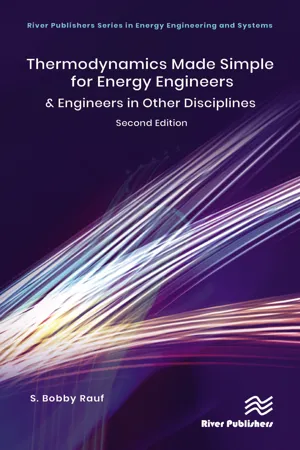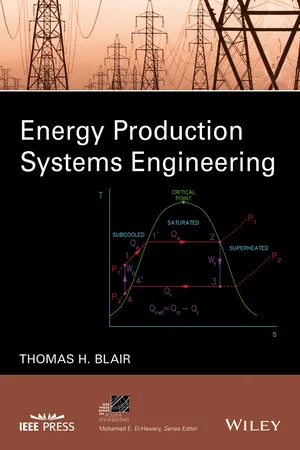Technology & Engineering
Isothermal Process
An isothermal process is a thermodynamic process in which the temperature of a system remains constant. This means that the internal energy of the system remains constant, and any heat added to or removed from the system results in a change in the system's volume or pressure. Isothermal processes are often used in engineering and technology to model and analyze the behavior of gases and other systems.
Written by Perlego with AI-assistance
Related key terms
3 Key excerpts on "Isothermal Process"
- eBook - ePub
Thermodynamics Made Simple for Energy Engineers
& Engineers in Other Disciplines
- S. Bobby Rauf(Author)
- 2023(Publication Date)
- River Publishers(Publisher)
8 Thermodynamic ProcessesTopics- Thermodynamic processes
- Heat engine cycles
- Steam turbines
- Temperature-enthalpy diagrams
- Pressure-enthalpy diagrams
- Pressure-volume diagrams
- Temperature-entropy diagrams
- Practical examples and associated case study.
8.1 Introduction
This chapter explores some of the mainstream thermodynamic processes, heat engines and heat engine cycles. Fundamentals of thermodynamic processes, heat engines, heat engine cycles and associated systems are explained and illustrated through process flow diagrams, graphs, tables and pictures. Practical significance, application, analytical methods, and computational techniques associated with heat engine cycles and thermodynamic processes are demonstrated through case study, examples and self-assessment problems.8.2 Thermodynamic Processes
Thermodynamic processes are processes that entail heat, internal energy, enthalpy, entropy, work, pressure, temperature and volume. In this section, we will explore the following thermodynamic processes and illustrate these processes with practical examples:- Adiabatic Process
- Isenthalpic Process
- Isochoric Process
- Isothermal Process
- Isobaric Process
- Isentropic Process
8.2.1 Adiabatic process
Adiabatic process is a thermodynamic process in which no heat either enters or leaves the thermodynamic system boundary. An adiabatic process can also be explained through the following mathematical statements or equations:(8.1)Δ U = − W(8.2)Δ Q = 0Equations 8.1 and 8.2 essentially state that in an adiabatic process, wherein no heat is gained or lost, any work performed on the system or by the system is transformed into a net change in the internal energy of the system. As specifically stated above, Eq. 8.1 - eBook - ePub
- Irving Granet, Jorge Alvarado, Maurice Bluestein(Authors)
- 2020(Publication Date)
- CRC Press(Publisher)
A reversible adiabatic process is isentropic. Isothermal: A process carried out at constant temperature. Principle of the increase of entropy: The entropy of an isolated system increases or in the limit remains the same. Reversible process: Any process performed so that the system and all its surroundings can be restored to their initial states by performing the process in reverse. Second law of thermodynamics: Heat cannot, of itself, pass from a lower temperature to a higher temperature. Thermal efficiency: The ratio of the net work of a cycle to the heat added to the cycle. Equations Developed in This Chapter Net work output η = net work output heat added × 100 (5.1) Thermal efficiency η = Q in − Q r Q in × 100 = [ 1 − Q r Q in ] × 00 (5.2) Kelvin temperature. function 0 1 Q 2 = T 1 T 2 (5.6) Efficiency of a reversible cycle η = T 1 − T 2 T 1 × 100 [ 1 − T 2 T 1 ] × 100 (5.7a) Entropy Δ S = Q T or Δ s = q T reversible process (5.8) Entropy change s 2 − s 1 = c ⋅ ln (T 2 T 1) (5.14) General property. relation T Δ s = Δ u + p Δ v J (5.16) General property relation T Δ s = Δ h + v Δ p J (5.23) General property relation (SI) T Δ s = Δ h − v Δ p (5.23a) Entropy increase principle Δ S ≥ 0 for all isolated systems (5.24) Isentropic efficiency during. compression η compression = w c, s w c, a = h 2, s − h 1 h 2, a − h 1 = Δ h s Δ h a (5.25) Isentropic efficiency during expansion η expansion (turbine) = w t, a w t, s = h 1 − h 2 a h 1 − h 2 s = Δ h a Δ h s (5.26) QUESTIONS 5.1 Can a heat engine do anything other than deliver work? 5.2 Define a cycle. 5.3 Thermal efficiency is defined. to be the ratio of net work to heat added in a cycle. Would you think that this is an appropriate definition to be used when a refrigerator is being discussed? 5.4 Do you know of any process in nature that is reversible? 5.5 There are four distinct events that occur in the Carnot cycle - eBook - ePub
- Thomas Howard Blair(Author)
- 2016(Publication Date)
- Wiley-IEEE Press(Publisher)
- Heat rate is a measure of the energy into the system divided by the energy out of a system.
- Isentropic process is a process that occurs at constant entropy.
- Isobaric process is a process that occurs at constant pressure.
- Isometric process is a process that occurs at constant volume.
- Isothermal Process is a process that occurs at constant temperature.
- Latent Heat Transfer – A process when energy is transferred and results in a change in the state of the material (i.e., change from liquid to gas), but the temperature remains constant.
- Natural Circulation – The circulation of water in a boiler caused by differences in density.
- Net plant heat rate (NPHR) is the amount of heat energy into a boiler divided by the net amount of energy out of the plant.
- Net turbine heat rate (NTHR) is the ratio of the heat energy into a turbine divided by the net mechanical energy output of the turbine.
- Pressure – The measure of force per unit area.
- Radiation is a process where electromagnetic waves directly transport energy through space.
- Sensible Heat Transfer – A process when energy is transferred and the transfer of energy results in a change in the temperature of the material, but the state of the material (i.e., solid, liquid, or gas) remains the same.
- Specific Volume – The measure of the volume that a material takes up for a specific amount of mass of the material.
- Specific Heat – The measure of the amount of energy that is transferred in the form of heat per unit mass.
- Temperature – The measure of the average molecular kinetic energy of a material.
- Throttling process is a process that occurs at constant enthalpy.
PROBLEMS
- A combined cycle power plant utilizes two thermal cycles to drive the two generators. One generator is driven by a combustion turbine and the other generator is driven by a steam turbine. What are the names of the two thermal cycles that are referenced by the term “combined cycle?”
Index pages curate the most relevant extracts from our library of academic textbooks. They’ve been created using an in-house natural language model (NLM), each adding context and meaning to key research topics.


